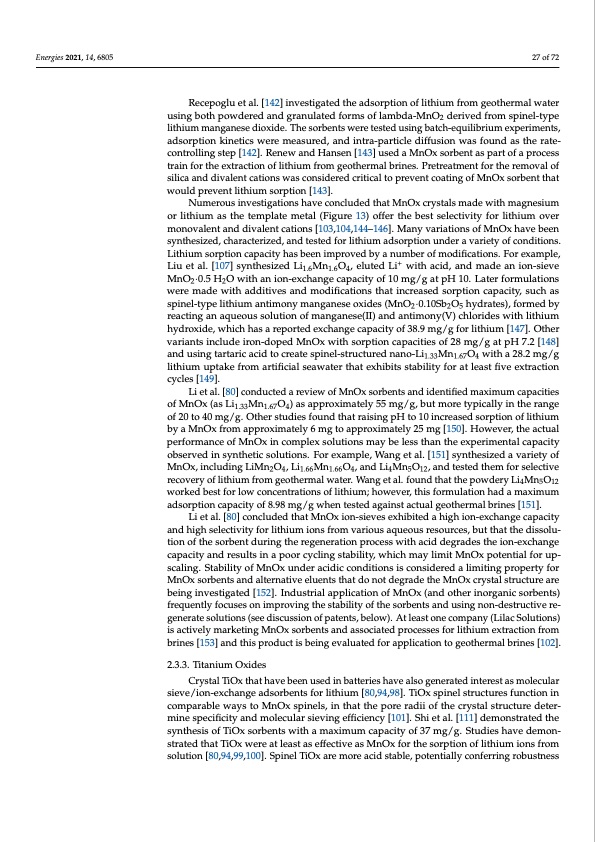
PDF Publication Title:
Text from PDF Page: 027
Energies 2021, 14, 6805 27 of 72 Recepoglu et al. [142] investigated the adsorption of lithium from geothermal water using both powdered and granulated forms of lambda-MnO2 derived from spinel-type lithium manganese dioxide. The sorbents were tested using batch-equilibrium experiments, adsorption kinetics were measured, and intra-particle diffusion was found as the rate- controlling step [142]. Renew and Hansen [143] used a MnOx sorbent as part of a process train for the extraction of lithium from geothermal brines. Pretreatment for the removal of silica and divalent cations was considered critical to prevent coating of MnOx sorbent that would prevent lithium sorption [143]. Numerous investigations have concluded that MnOx crystals made with magnesium or lithium as the template metal (Figure 13) offer the best selectivity for lithium over monovalent and divalent cations [103,104,144–146]. Many variations of MnOx have been synthesized, characterized, and tested for lithium adsorption under a variety of conditions. Lithium sorption capacity has been improved by a number of modifications. For example, Liu et al. [107] synthesized Li1.6Mn1.6O4, eluted Li+ with acid, and made an ion-sieve MnO2·0.5 H2O with an ion-exchange capacity of 10 mg/g at pH 10. Later formulations were made with additives and modifications that increased sorption capacity, such as spinel-type lithium antimony manganese oxides (MnO2·0.10Sb2O5 hydrates), formed by reacting an aqueous solution of manganese(II) and antimony(V) chlorides with lithium hydroxide, which has a reported exchange capacity of 38.9 mg/g for lithium [147]. Other variants include iron-doped MnOx with sorption capacities of 28 mg/g at pH 7.2 [148] and using tartaric acid to create spinel-structured nano-Li1.33Mn1.67O4 with a 28.2 mg/g lithium uptake from artificial seawater that exhibits stability for at least five extraction cycles [149]. Li et al. [80] conducted a review of MnOx sorbents and identified maximum capacities of MnOx (as Li1.33Mn1.67O4) as approximately 55 mg/g, but more typically in the range of 20 to 40 mg/g. Other studies found that raising pH to 10 increased sorption of lithium by a MnOx from approximately 6 mg to approximately 25 mg [150]. However, the actual performance of MnOx in complex solutions may be less than the experimental capacity observed in synthetic solutions. For example, Wang et al. [151] synthesized a variety of MnOx, including LiMn2O4, Li1.66Mn1.66O4, and Li4Mn5O12, and tested them for selective recovery of lithium from geothermal water. Wang et al. found that the powdery Li4Mn5O12 worked best for low concentrations of lithium; however, this formulation had a maximum adsorption capacity of 8.98 mg/g when tested against actual geothermal brines [151]. Li et al. [80] concluded that MnOx ion-sieves exhibited a high ion-exchange capacity and high selectivity for lithium ions from various aqueous resources, but that the dissolu- tion of the sorbent during the regeneration process with acid degrades the ion-exchange capacity and results in a poor cycling stability, which may limit MnOx potential for up- scaling. Stability of MnOx under acidic conditions is considered a limiting property for MnOx sorbents and alternative eluents that do not degrade the MnOx crystal structure are being investigated [152]. Industrial application of MnOx (and other inorganic sorbents) frequently focuses on improving the stability of the sorbents and using non-destructive re- generate solutions (see discussion of patents, below). At least one company (Lilac Solutions) is actively marketing MnOx sorbents and associated processes for lithium extraction from brines [153] and this product is being evaluated for application to geothermal brines [102]. 2.3.3. Titanium Oxides Crystal TiOx that have been used in batteries have also generated interest as molecular sieve/ion-exchange adsorbents for lithium [80,94,98]. TiOx spinel structures function in comparable ways to MnOx spinels, in that the pore radii of the crystal structure deter- mine specificity and molecular sieving efficiency [101]. Shi et al. [111] demonstrated the synthesis of TiOx sorbents with a maximum capacity of 37 mg/g. Studies have demon- strated that TiOx were at least as effective as MnOx for the sorption of lithium ions from solution [80,94,99,100]. Spinel TiOx are more acid stable, potentially conferring robustnessPDF Image | Recovery of Lithium from Geothermal Brines

PDF Search Title:
Recovery of Lithium from Geothermal BrinesOriginal File Name Searched:
energies-14-06805-v2.pdfDIY PDF Search: Google It | Yahoo | Bing
Product and Development Focus for Infinity Turbine
ORC Waste Heat Turbine and ORC System Build Plans: All turbine plans are $10,000 each. This allows you to build a system and then consider licensing for production after you have completed and tested a unit.Redox Flow Battery Technology: With the advent of the new USA tax credits for producing and selling batteries ($35/kW) we are focussing on a simple flow battery using shipping containers as the modular electrolyte storage units with tax credits up to $140,000 per system. Our main focus is on the salt battery. This battery can be used for both thermal and electrical storage applications. We call it the Cogeneration Battery or Cogen Battery. One project is converting salt (brine) based water conditioners to simultaneously produce power. In addition, there are many opportunities to extract Lithium from brine (salt lakes, groundwater, and producer water).Salt water or brine are huge sources for lithium. Most of the worlds lithium is acquired from a brine source. It's even in seawater in a low concentration. Brine is also a byproduct of huge powerplants, which can now use that as an electrolyte and a huge flow battery (which allows storage at the source).We welcome any business and equipment inquiries, as well as licensing our turbines for manufacturing.| CONTACT TEL: 608-238-6001 Email: greg@infinityturbine.com | RSS | AMP |